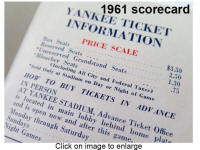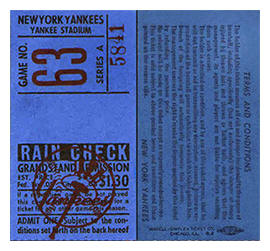The Correct Method for Authenticating
Undated Ticket Stubs
October 2014
A study in dating Grandstand
Ticket Stubs reveals that collectors are spending
thousands of dollars on ticket stubs that are not
correctly dated. Ticket stubs that are being sold on eBay,
private
auction houses and authenticated by trusted companies such as PSA, and SGC.
Since Yankee Stadium opened
in 1923, and up until at least 1979 the date was not
included on Grandstand & Bleacher ticket stubs. The
importance of dating a ticket stub correctly could
mean the difference of the stub having a collectors value of
$20. or a value of $4,000. A mistake by just one year for a
game number could be the difference.

Using ticket prices, sales tax information, the name of the printing
company, team logo, game number, team president, and
ticket design, these undated stubs can be narrowed down to
a specific year, if not within a range of a year or two.
The ticket on the right is from 1972 but was dated to 1961
by PSA. Correct Method in Dating the
Ticket
on the right
A -
The first step in dating a ticket stub would be to check
the price. If PSA would have checked this first it would
have sent up a red flag on the date that was rubber
stamped onto this stub. As listed in the 1961 Yankees
Scorecard, the price for a grandstand ticket was $1.30.
Grandstand tickets from 1962 to 1976 had a price of a $1.50
with the exception of 1974 ($1.30)
Note: Pictured below is the ticket prices
from the 1961 Yankees scorecard. The grandstand ticket is
a $1.30 (including All City & Federal Taxes)
 B
- The Tax line
on this ticket reads "State & City Tax" This line rules
out the stub being dated before 1966. New York State did
not adopt a sales tax until August of 1965. The State tax
was not added to the sale of tickets until 1966, and the
abbreviation ST. for State (ST. & City) is used from
1966-1969. It is not until 1970 when the stubs read "State
& City" The wording of this tax information can be found
on all dated tickets for each year from 1970-1979. B
- The Tax line
on this ticket reads "State & City Tax" This line rules
out the stub being dated before 1966. New York State did
not adopt a sales tax until August of 1965. The State tax
was not added to the sale of tickets until 1966, and the
abbreviation ST. for State (ST. & City) is used from
1966-1969. It is not until 1970 when the stubs read "State
& City" The wording of this tax information can be found
on all dated tickets for each year from 1970-1979.
C -
The small sized Yankees logo watermark (9/16" diameter) on
this ticket was not used until 1970. From 1951 through
1969 the grandstand tickets featured a Yankees logo
Watermark that
measured 15/16" in diameter. This change in design also
coincides with the Yankees switching to a new printing
company to print Grandstand and Bleacher tickets.

Pictured to the right is a Grandstand ticket stub
(correctly dated to 1961) that features the 15/16" Yankees
logo used from 1951-1969, the correct price of a $1.30,
the correct tax line (Fed & City as opposed to State &
City), and the printing company credit line,
Ansell-Simplex Ticket Co.
D - The
Printing company credit line featured on the back of the
ticket stub above reads "National Ticket Co. Shamokin PA"
This company was not used by the Yankees for the printing
of Grandstand tickets until 1970. The Ansell-Simplex
Ticket Co. was used to print all tickets from 1951-1969,
the same years the 15/16" Yankees Logo watermark design
was used.
The date of a Grandstand ticket
stub cannot be identified by a date plugged by a rubber
stamp, or even by the writing placed there by a collector
or the attendee to the game. In my study I only found 3
stubs out of a thousand that were dated with a rubber
stamp. All 3 can be proven to be dated wrong, and all 3
were dated to games attributing them to a significant player
milestone, with high collectors value.
 I
have found a hoard of stubs with the wrong date
mistakenly written on them by collectors, with no doubt
that they are wrong. Pictured on the left is a ticket stub
with the wrong year ('69) written on the back by the
person that attended the game, along with the correct game
details, and the game date is printed on the front
('68). It happens. We all make mistakes, I
have found a hoard of stubs with the wrong date
mistakenly written on them by collectors, with no doubt
that they are wrong. Pictured on the left is a ticket stub
with the wrong year ('69) written on the back by the
person that attended the game, along with the correct game
details, and the game date is printed on the front
('68). It happens. We all make mistakes,
It should not be taken for granted that if a stub is being
sold
with a program, that the two came from the same game or
even the same year. I have also found many stubs being
sold with programs from different years. Outside of stubs
being stapled to the cover, and believe me I have found
some that just came short of being welded to the program,
loose stubs can be separated from the correct program and
mistakenly placed with the wrong one.
The ticket stub pictured above,
that was authenticated by PSA as being dated to September
26, 1961, the game Roger Maris hit his 60th home run to
tie Babe Ruth for the single season home run record, sold
for $717. and is in fact from 1972.
The information described above
(price, Tax info, stub design & printing company) narrows
the date to the 1970-1972 era. The .10 cents sales tax
(.09 cents in 1971) dates it to 1972 or 1973 but in '73
the design and size of the ticket is changed, and the term
"Grandstand" is dropped in favor of "General Admission." For more information
on correctly dating Grandstand and Bleacher ticket stubs, visit the
Grandstand Rain
Check Ticket Stub Dating Guide
TOP OF PAGE
BACK TO
KeyMan Collectors Corner
|
